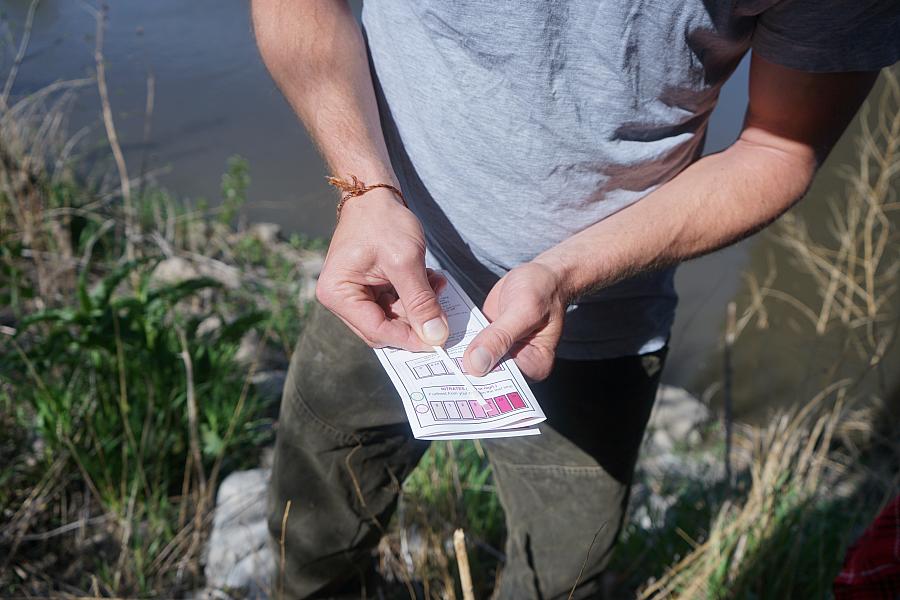Excessive nitrate in groundwater is hurting rural and small-town Nebraskans

(Photo via Yanqi Xu/Flatwater Free Press)
Many Nebraskans consider the wealth of groundwater in the state a gift that makes large-scale irrigation farming possible. However, that water is increasingly laced with nitrate.
Nitrate, odorless, colorless and tasteless, exists naturally. It’s in vegetables. It comes from organic waste like manure produced by cattle. But it is often converted from manmade sources like commercial fertilizers applied to lawns, golf courses, and especially to corn.
Nitrate is one of the main form of nitrogen source for plant uptake. It powers the state’s corn industry. But it is also soluble and prone to leaching, especially on sandy soils and when there’s excessive rainfall or irrigation.
The water can wash the nitrate down past the root zone and into our groundwater. Groundwater provides drinking water to 85% of residents in Nebraska, the sixth-highest rate in the country.
The federal Safe Drinking Water Act regulates public water systems and requires notices and treatment if nitrate level is over 10 parts per million in public water systems. However, there are no state or federal requirements on private wells. Rural residents are often left to pay for the cost of testing and treating their water on their own.
However, there is essentially no regulation on the amount of fertilizer farmers can apply to their fields. Neither the state nor local governments control how much nitrogen fertilizer a farmer can use.
The median nitrate level of each year’s tested water samples in Nebraska has trended up over the past 40 years, according to the most recent monitoring report from the state Department of Environment and Energy.
And research shows that it’s dangerous.
Nitrate is known to cause methemoglobinemia, commonly known as blue baby syndrome. It can cause developmental delay, heart failure or even deaths.
But some research has also identified a geographic correlation between high nitrate and high pediatric cancer rates. A group of researchers at the University of Nebraska identified a correlation between high nitrate and increased risks of certain health conditions, including pediatric cancer and birth defects. Nebraska has the seventh-highest pediatric cancer rate in the nation.
In short, Nebraska’s children may be sickened by our corn and cattle industries. And the state’s failure to regulate them.
Fertilizer application data from the USDA shows that Nebraska leads the nation in fertilizer use per acre of corn. Despite recommendations to avoid applying fertilizers in the fall and only in small amounts each application, some growers don’t always follow these recommendations.
The state’s 23 natural resources districts (NRDs) are tasked with overseeing water quality. However, a number of regulators say that the NRDs can make recommendations but don’t have the legal authority or the manpower to monitor fertilizer use in practice. The NRD board members, elected locally, are often reluctant to police their neighbors. They prefer education over regulation. Some efforts to make rules at NRDs have failed.
We are at a point where we know that the nitrate issue isn't going to get better without effective intervention.
Some have called for more regulation of large animal feeding operations. In the Lower Elkhorn Natural Resource District, the state has issued about 1,800 permits for concentrated animal feeding operations. Less than 6% of those operations have monitoring wells installed for groundwater testing, according to local NRD officials.
A bill to enhance training for farmers on nitrate became law this year.
Multiple small towns and cities have been battling the nitrate problem, sometimes spending millions of dollars on a treatment plant. The city of Hastings has spent millions of dollars installing filtration systems for the city’s municipal water lines.
For the story I’ve reported for the Flatwater Fress Press, I will feature impacted families in areas plagued by high nitrate, and their struggles with treating water and battling their children’s diseases, including cancer. I’ve analyzed data from the state’s Groundwater Quality Clearinghouse and have created maps and graphs showing the areas hit hardest by high nitrate and show how efforts to manage nitrate have fallen short. I’ve talked to experts and stakeholders to present solutions.
My hope for the project is to engage with and inform rural residents on how to test their wells and treat their water. We’re hopeful our reporting is finally shining a light on one of the most important issues for generations of Nebraskans to come.
